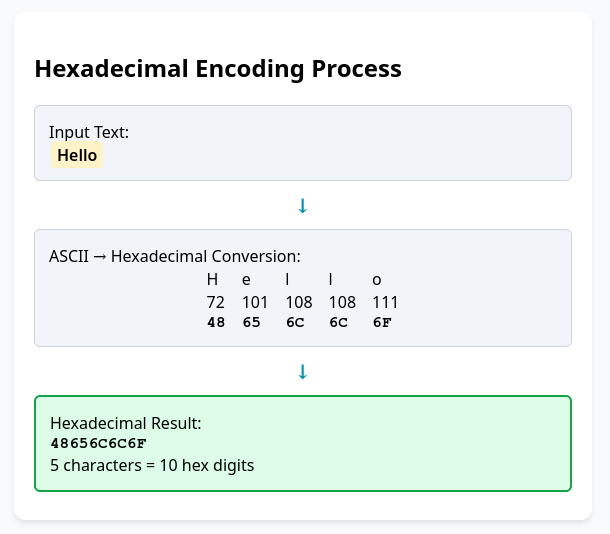Hex Encoder & Decoder Tool
Convert text to hexadecimal representation or decode hex strings back to readable text. Hexadecimal encoding is essential for programming, debugging, data analysis, and working with binary data in a human-readable format.
Operation Mode
Hex Options
Input Text
Hexadecimal Result
Enter text to see hex conversion
Statistics
Quick Examples
About Hexadecimal Encoding
Hexadecimal encoding converts text into base-16 representation, using digits 0-9 and letters A-F to represent byte values.
Common Uses:
- • Data visualization
- • Binary file analysis
- • Color codes (CSS)
- • Memory addresses
Examples:
- • A → 41
- • Space → 20
- • @ → 40
- • 0 → 30
What is Hexadecimal Encoding?
Hexadecimal encoding converts text and data into base-16 representation using digits 0-9 and letters A-F (or a-f). Each byte of data is represented by exactly two hexadecimal characters, making it a compact and readable way to represent binary data.
Key characteristics of hexadecimal encoding:
- Base-16 system: Uses 16 characters (0-9, A-F)
- Byte representation: Each byte = 2 hex characters
- Human readable: More compact than binary
- Programming standard: Widely used in development
Example: "Hello" becomes "48656c6c6f"

Features of Our Hex Encoder Tool:
- Real-time conversion - Instant encoding/decoding as you type
- Flexible formatting - Choose separators and case preferences
- UTF-8 support - Handles Unicode characters properly
- Multiple separators - Space, colon, dash, comma, or none
- Case options - Uppercase (A-F) or lowercase (a-f) hex digits
- Byte statistics - Shows detailed encoding metrics
- Error detection - Identifies invalid hex sequences
- Browser-based - No data sent to servers, complete privacy
How to Use the Hex Encoder Tool
1. Select Operation Mode
Choose "Encode to Hex" to convert text to hexadecimal, or "Decode from Hex" to convert hex strings back to readable text.
2. Configure Hex Options
For encoding, choose your preferred format: uppercase/lowercase hex digits and separator style (none, space, colon, dash, or comma).
3. Enter Your Data
Type or paste your text (for encoding) or hex string (for decoding) in the input field. Conversion happens automatically.
4. Copy Results
Use the copy button to copy the converted result to your clipboard for use in code, documentation, or analysis.
Hexadecimal Encoding Examples
| Original Text | Hexadecimal | With Separators |
|---|---|---|
| Hello | 48656c6c6f | 48:65:6c:6c:6f |
| 123 | 313233 | 31 32 33 |
| A | 41 | 41 |
| @#$ | 402324 | 40-23-24 |
Common Uses for Hexadecimal Encoding
Hexadecimal encoding is widely used across various technical fields:
- Programming & Development - Representing byte values in code
- Web Development - CSS color codes (#FF0000 for red)
- Debugging - Analyzing binary data and memory dumps
- Cryptography - Displaying hash values and keys
- Network Analysis - Examining packet data
- File Analysis - Hex editors for binary file inspection
- Data Recovery - Low-level disk and file analysis
- Embedded Systems - Hardware programming and configuration
Hexadecimal Format Options
Case Styles
Separator Styles
ASCII to Hex Reference Table
Common ASCII characters and their hexadecimal values:
Numbers (0-9)
Uppercase (A-Z)
Special Characters
Unicode and UTF-8 Support
Our hex encoder properly handles Unicode characters by first converting them to UTF-8 bytes, then encoding each byte to hexadecimal:
Related Encoding Tools
Explore these related encoding and decoding tools:
Binary Encoder/Decoder
Convert text to binary (base-2) representation or decode binary strings back to text.
Try our Binary Encoder tool →Base64 Encoder/Decoder
Encode and decode text using Base64 encoding for data transmission and storage.
Try our Base64 Encoder tool →Frequently Asked Questions
What's the difference between hex and other number systems?
Hexadecimal (base-16) uses 16 symbols (0-9, A-F), binary (base-2) uses 2 symbols (0-1), and decimal (base-10) uses 10 symbols (0-9). Hex is more compact than binary while remaining human-readable.
Why do programmers use hexadecimal?
Hex is convenient because each hex digit represents exactly 4 bits, making it easy to convert to/from binary. Two hex digits represent one byte, which is fundamental in computing.
Can I decode any hex string?
You can decode valid hex strings that contain only characters 0-9 and A-F (or a-f). Invalid characters or odd-length strings will produce errors.
How do I handle special characters and emojis?
Our tool automatically handles Unicode characters by converting them to UTF-8 bytes first, then encoding each byte to hex. This ensures proper representation of all characters.
What separator should I use for hex output?
Choose based on your use case: no separator for compact storage, spaces for readability, colons for MAC addresses, or dashes for UUID-style formatting.
Is uppercase or lowercase hex better?
Both are functionally identical. Uppercase (A-F) is traditional in many contexts, while lowercase (a-f) is common in web development and modern programming.
Technical Implementation
Our hex encoder uses JavaScript's TextEncoder API for proper UTF-8 handling:
This approach ensures:
- Proper UTF-8 encoding for Unicode characters
- Consistent two-character hex representation per byte
- Flexible formatting options for different use cases
- Cross-browser compatibility
Why Use Our Hex Encoder?
Developer-Friendly Features:
- • Real-time conversion
- • Multiple output formats
- • UTF-8 Unicode support
- • Error detection & validation
Privacy & Security:
- • Client-side processing only
- • No data sent to servers
- • Works offline
- • Open source algorithms